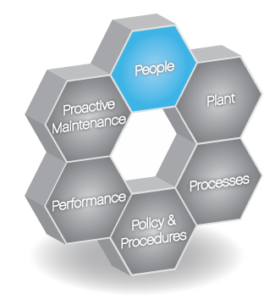Plant Hexcellence™ drives culture change. People drive sustainability.
We as employers, hire employees but what shows up every morning are people. They carry with them baggage, but the same things that create the imperfect person, also are the same things that give them strength, integrity, loyalty, and ingenuity.
 It was not an accident that the top and most prominent position of the model is People. Success or failure of your company/organization all starts with your people (if you haven’t read the book by Cliff Williams, titled “People – A Reliability Success Story,” you must!). You can have the best patented new-fangled process or software ever created, but unless you have the right people resource to produce it and bring it to market, then you will struggle and fail. In all companies, there must be a balance between Safety, Environmental, and Profit. People are the one true component of all three and the hardest to control and maintain.
It was not an accident that the top and most prominent position of the model is People. Success or failure of your company/organization all starts with your people (if you haven’t read the book by Cliff Williams, titled “People – A Reliability Success Story,” you must!). You can have the best patented new-fangled process or software ever created, but unless you have the right people resource to produce it and bring it to market, then you will struggle and fail. In all companies, there must be a balance between Safety, Environmental, and Profit. People are the one true component of all three and the hardest to control and maintain.
Each cell is composed of facets or sides, and as a cut on a gemstone, each is important to the overall beauty of the stone. One facet missing or being the wrong shape or size diminishes the end result greatly. Even though each company or organization vary greatly, the flexibility of the model allows that each facet is “Fit for Purpose” for that company.
The following are the facets within the People cell of the Hexcellence™ Model
- Organization Development
- Organizational Structure
- Continuous Improvement
- Change Management
- Operational Excellence
Organization Development is about change. Changing the culture. Changing the knowledge base. Changing the sustainability of the company.
Change is hard. Change traditionally only occurs when an outside agent or factor demands the change for whatever the reason. I have found that most people say, “I don’t mind change. In fact, change is good”. What they really mean is “I don’t mind change as long as it doesn’t affect me”. Even the most forward-thinking advocates of change, push back when their world is threatened with change.
The first step in change as is the first step in Asset Management initiatives is understanding where you are going before you begin the journey. So the first step in Organization Development is having a Vision and Mission. Keep in mind that we are talking specifically about the Manufacturing Excellence component of change. The vision/mission/key pursuits are not fluffed or commonly referred to as “apple pie and motherhood”. We are talking real, tangible, definable and measurable goals. This should be done through a facilitated approach using an outside agent to facilitate the process.
The next step is to look at the Roles/ Responsibility/Expectations/ Measures (RREM).
Once the RREM is defined completely, then breaking down the Roles and Responsibilities into skills required to exceed expectations and sustain the change creates the foundation for;
- Comparative analysis of where your organization’s people are currently?
- What training does the organization need to attain the level of proficiency required?
- Foundation for a certification process ensures sustainability of the knowledge and competency.
- Tying the skills and competencies to personal performance evaluations ensures motivation from employees
Utilizing the RREM, create the Organizational Structure to manage the accountability of the roles that support the goal.
An organizational structure defines how activities such as task allocation, coordination, and supervision are directed towards the achievement of organizational aims.
On the topic of new staff, the newer generations of workers are looking for different things in an organization, such as the ability to grow and learn new things, succession plans, challenges and the ability to make a difference. Recognizing the differences between the newer generations and older generations of workers will allow the organization to develop a plan to attract and retain the right people and competencies.
Continuous Improvement/Change Management
The traditional model of organizational management has in large part been a top-down philosophy following the standard hierarchical organizational chart, where employees at the lowest level of the organization are not afforded the opportunity to contribute to the overall success of the organization. Whereas this traditional model is unavoidable and cannot be dismissed, successful leaders who embrace change management and understand the value of every employee in the organization, foster an environment that supports floor level ownership, accountability for results at all levels of the organization, and drives sustainability.
Operational Excellence
Operational Excellence is the utilization of the Hexcellence™ Model to support the leadership to employ specific strategy, methods, and tools that drive sustainable improvement. Those tools are:
- Total Productive Maintenance (TPM) – Which focuses on improving the Overall Equipment Effectiveness through employment of improved maintenance strategies
- Lean – Is the elimination of waste in a manufacturing environment to include optimization of all processes and resources.
- Six Sigma – Statistical Analysis to identify key areas of focus for the improvements to take place
- 5S – A method to clean and organize an area of all required assets and tools while removing any unnecessary components and contributing factors.
- Self-empowered Work Teams – Allow Teams to identify and solve issues and defects in the process autonomously
All the facets within the People cell are necessary. The degree and depth to which an organization uses them give the flexibility for smaller companies to see the same results as a large with a cost structure that makes business sense.
The People cell focuses on the Human Assets of an Asset Management program. With the looming skills shortage and the career approach seen by the newer generation, the focus on People is becoming even more pressing. This cell is not to be tackled alone either. There must be a joint effort with the HR team to drive improvements in this cell and ensure the sustainability of the program. Without the right staff, competency, or culture, the Asset Management will not work!
So what Human Capital program does your organization have in place to attract the right talent and competency while keeping them in the organization? This very question was posed to a panel of executives at a recent conference, but I want to hear what you and your organization is doing. This is not an easy task but is critical to the long-term success of your Asset Management program. Share what you have done with your Human Capital program so that others may learn.
And one last thing… if you are worried about training staff and having them leave… what happens if you don’t train them and they stay? (I believe Richard Branson said this, but I may be incorrect)
The Plant Hexcellence Model is a proven model that was developed by Scott Kelley at Geometric Reliability but is the model of choice for Eruditio, LLC. If you are interested in the Plant Hexcellence model for your site or organization, please contact [email protected].
Remember, to find success; you must first solve the problem, then achieve the implementation of the solution, and finally sustain winning results.
I’m James Kovacevic
Eruditio, LLC
Where Education Meets Application
Follow @EruditioLLC
References;
- Plant Hexcellence Model
- Free PDF Download on Plant Hexcellence – People
- Scott Kelley
- Geometric Reliability
- The Importance of People in an Asset Management Model – Rooted In Reliability
- The Importance of an Asset Management Model – Rooted In Reliability
- The ABC’s of Asset Management – Rooted In Reliability
- People – A Reliability Success Story by Cliff Williams
*This post was originally written by Scott Kelley of Geometric Reliability and modified by James Kovacevic


